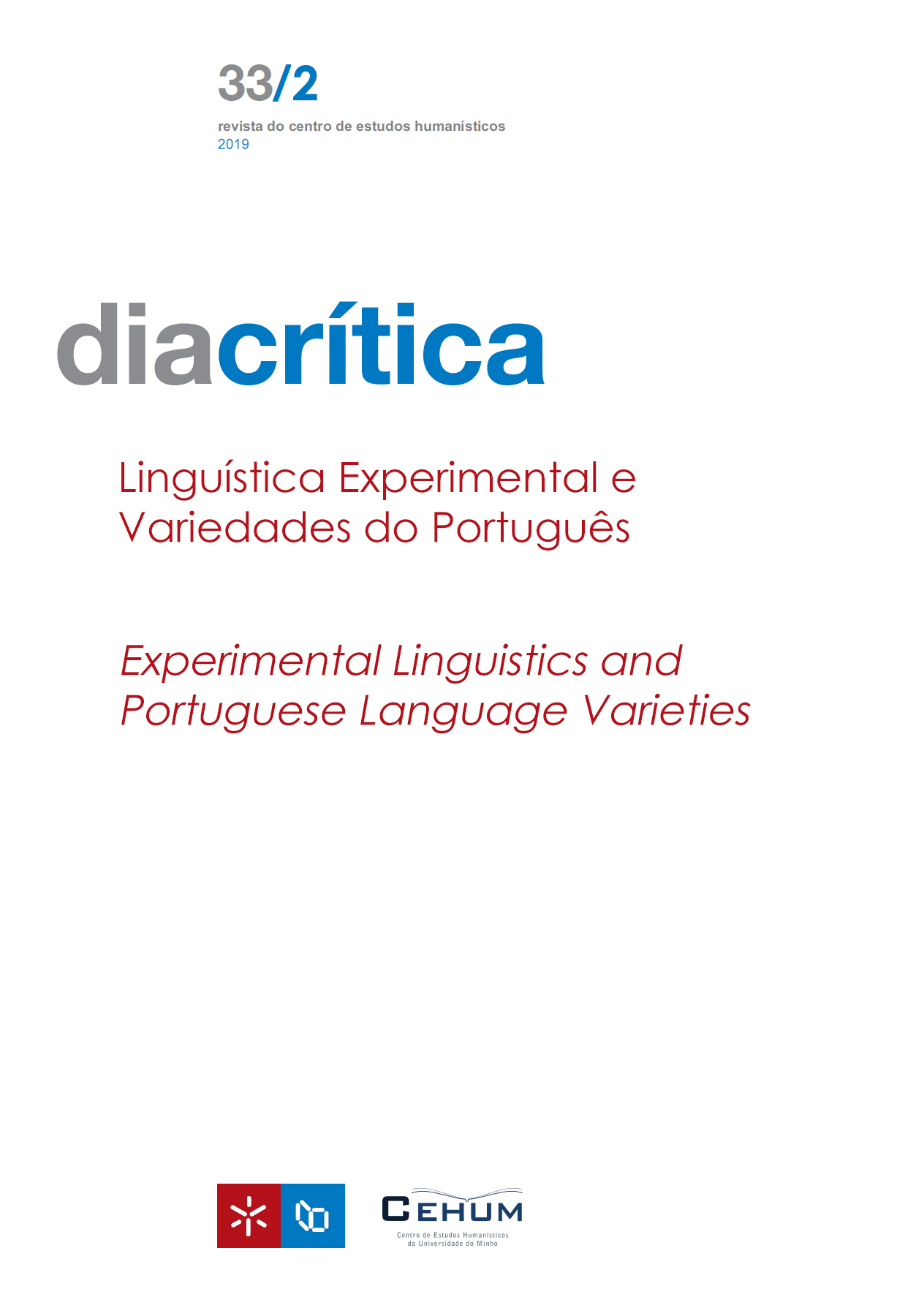Tipo: Innovation and change in brazilian portuguese
DOI:
https://doi.org/10.21814/diacritica.5061Keywords:
Innovation and change, Brazilian Portuguese, TeenagersAbstract
This paper provides an empirical account of the synchronic variation in the use of the noun tipo (‘type’, ‘kind’) in the Brazilian Portuguese vernacular. Innovation in its use, first documented by Bittencourt (1999), suggests tipo may be performing functions beyond those of a noun. To investigate innovation in its use, this study focuses on the speech of teenagers born and raised in Rio de Janeiro. Although this group has been shown to be in the forefront of linguistic innovation (D’Arcy 2005; Tagliamonte 2016; Tagliamonte & D’Arcy 2009), research on the speech of adolescents remains scant in Brazilian Portuguese. This paper aims to fill this gap by presenting the results of two analyses of empirical data collected between 2015 and 2018 (C. P. Thompson & Onosson 2016). Results indicate that tipo is not only salient in participants’ speech but also that non-nominal forms of tipo are more frequently used by speakers (97.98%) when compared to its nominal form (2.02%). Findings suggest that uses of non-nominal tipo are systematic and linguistically defined: tipo is most often found in pre-clausal position or preceding a noun phrase. Findings also show that tipo is performing functions beyond those of a noun, such as a preposition and an adverb.
References
Bauer,L.(1994). Watching English change. London, UK: Longman.
Bertozzo, A. F. (2014).De conector a marcador discursivo: “Como,” “que nem” e “tipo” em Chapecó(Master’sthesis, Federal University ofFronteira Sul, Chapecó, Brazil).
Bittencourt, V. (1999). Gramaticalização e discursivização no português oral do Brasil: O caso “tipo(assim)”.Scripta,2(4), 39–53.
Boersma, P. & Weenink, D. (2019). Praat: Doing phonetics by computer (Version 6.0.46)[Computer software]. Retrieved fromhttp://www.praat.org/
Braga, M. L. (2003). Aíe entãoem expressões cristalizadas.Cadernos de Estudos Lingüísticos,44, 169–177.https://doi.org/10.20396/cel.v44i0.8637073 DOI: https://doi.org/10.20396/cel.v44i0.8637073
Brinton, L. J. (1996).Pragmatic markers in English: Grammaticalizationand discourse functions. New York, USA: Mouton de Gruyter. DOI: https://doi.org/10.1515/9783110907582
Brinton, L. J. & Traugott, E. C. (2005).Lexicalization and language change. New York, USA: Cambridge University Press. DOI: https://doi.org/10.1017/CBO9780511615962
Brugman, H.&Russel, A. (2004). Annotating multimedia/ multi-modal resources with ELAN. In M. T. Lino, M. F. Xavier, F. Ferreira, R. Costa & R. Silva (Eds.), Proceedings ofthe Fourth International Conference on Language Resources and Evaluation(LREC’04)(pp. 2065–2068).
Carioca. (n.d.). InDicionário Ilustrado Tupi-Guarani. RetrievedJanuary 15, 2019,fromhttps://www.dicionariotupiguarani.com.br/dicionario/carioca/
D’Arcy, A. F. (2005).Like: Syntax and development(Doctoral thesis,University of Toronto, Toronto, CA).
de Brito, E. P. (2016). The variation of post-vowel -s in the Portuguese dialect of Rio de Janeiro.Cadernos de Estudos Lingüísticos,58(1), 139–151. DOI: https://doi.org/10.20396/cel.v58i1.8646158
de Castilho, C. M. M. (1991).Os delimitadores no português faladono Brasil(Master’sthesis,State University ofCampinas, Campinas, Brazil).
Eckert, P. (1988). Adolescent social structure and the spread of linguistic change.Language in Society,17(2), 183–207.https://doi.org/10.1017/S0047404500012756 DOI: https://doi.org/10.1017/S0047404500012756
Eckert, P. (2014). Language and gender in adolescence. In S. Ehrlich, M. Meyerhoff, & J. Holmes (Eds.),The handbook oflanguage, gender, and sexuality(pp. 529–545). MA, USA: Wiley Blackwell.https://doi.org/10.1002/9781118584248.ch27 DOI: https://doi.org/10.1002/9781118584248.ch27
Fernández, J. (2017). The language functions of tipoin Argentine vernacular.Journal of Pragmatics,114, 87–103.https://doi.org/10.1016/j.pragma.2017.03.013 DOI: https://doi.org/10.1016/j.pragma.2017.03.013
Hopper, P. J. & Traugott, E. C. (2003).Grammaticalization(2nd ed.). Cambridge, UK: Cambridge University Press. DOI: https://doi.org/10.1017/CBO9781139165525
Kolyaseva, A. & Davidse, K. (2018). A typology of lexical and grammaticalized uses of Russian tip, tipa, po tipu.RussianLinguistics,42(2), 191–220.https://doi.org/10.13140/RG.2.2.26504.01288 DOI: https://doi.org/10.1007/s11185-018-9193-9
Labov, W. (1984). Field methods of the project on linguistic change and variation. InJ. Baugh &J. Sherzer (Eds.),Language in use: Readings in sociolinguistics(pp. 28–54). Englewood Cliffs, N.J: Prentice-Hall.
Laurentino, J. J. (2016).Funções morfossintáticas e discursivas do tipona fala de jovens natalenses(Master’sthesis, Federal University ofRio Grande do Norte, Rio Grande do Norte, Brazil).
Lima-Hernandes, M. C. P. (2005).A interface sociolingüística/gramaticalização: Estratificação de usos de tipo, feito, igual e como-Sincronia e diacronia(Doctoral thesis, State University ofCampinas, Campinas, Brazil).
Martelotta, M. E. & da Silva, L. R. (1996). Gramaticalização de então. In M. E. Martelotta, S. J. Votre & M. M. Cezario (Eds.),Gramaticalização no português do Brasil: Uma abordagem funcional. Rio de Janeiro, Brazil: Departamento de Lingüística e Filologia-UFRJ.
Mihatsch, W. (2016). Type-noun binominals in four Romance languages.Language Sciences,53, 136–159. https://doi.org/10.1016/j.langsci.2015.05.009 DOI: https://doi.org/10.1016/j.langsci.2015.05.009
PEUL -Programa de Estudos sobre o Uso da Língua.(n.d.). Bancodedados[Data set].Retrieved April 4, 2018, from http://www.letras.ufrj.br/peul/index.html
Pezatti, E. G. (2001). O advérbio entãojá se gramaticalizou como conjunção?.Delta,17(1), 81–95.https://doi.org/10.1590/S0102-44502001000100004 DOI: https://doi.org/10.1590/S0102-44502001000100004
Tagliamonte, S. (2005). So who? Like how? Just what? Discourse markers in the conversations of young Canadians.Journal of Pragmatics,37(11), 1896–1915.https://doi.org/10.1016/j.pragma.2005.02.017 DOI: https://doi.org/10.1016/j.pragma.2005.02.017
Tagliamonte, S. (2016).Teen talk. Cambridge, UK: Cambridge University Press. DOI: https://doi.org/10.1017/CBO9781139583800
Tagliamonte, S. & D’Arcy, A. (2009). Peaks beyond phonology: Adolescence, incrementation, and language change.Language,85(1), 58–108.https://doi.org/10.1353/lan.0.0084 DOI: https://doi.org/10.1353/lan.0.0084
Tavares, M. A. (1999). A gramaticalização do aícomo conector -Indícios sincrônicos.Working Papers em Lingüística,3, 129–141.
Thompson, C. P. (2019, March). Innovation and change in Brazilian Portuguese: Tipo, Brazil’s like. Paper presented at the22ndAnnual Hispanic and Lusophone Studies Symposiumin Columbus, Ohio.
Thompson, C. P. & Onosson, D. S. (2016, November).Urban youth in Rio de Janeiro: Contemporary linguistic variation in Brazilian Portuguese. Poster session presented at the New Ways of Analyzing Variation 45, Vancouver, CA.
Thompson, H.V. G. (2013).Do léxico à gramática: Os diferentes usos de tipo(Master’sthesis, Federal University ofRio de Janeiro, Rio de Janeiro, Brazil).
Traugott, E. C. (2008). The grammaticalization of NP of NP patterns. In A. Bergs & G. Diewald (Eds.),Constructions and language change(pp. 23–46). Berlin, Germany: Mouton de Gruyter. DOI: https://doi.org/10.1515/9783110211757.23
Voghera, M. (2013). A case study on the relationship between grammatical change and synchronic variation: The emergence of tipo in Italian. In A. G. Ramt, C. Mauri & P. Molinelli (Eds.),Synchrony and diachrony: A dynamic interface. Amsterdam, The Netherlands: John Benjamins Publishing. DOI: https://doi.org/10.1075/slcs.133.12vog
Weinreich, U., Labov, W. & Herzog, M. (1968). Empirical foundations for a theory of language change. In L. Lehmann & Y. Malkiel (Eds.),Directions for historical linguistics(pp. 98–188). Texas, USA: University of Texas Press.
Downloads
Published
How to Cite
Issue
Section
License
Copyright (c) 2023 Christiani P. Thompson

This work is licensed under a Creative Commons Attribution-NonCommercial 4.0 International License.










